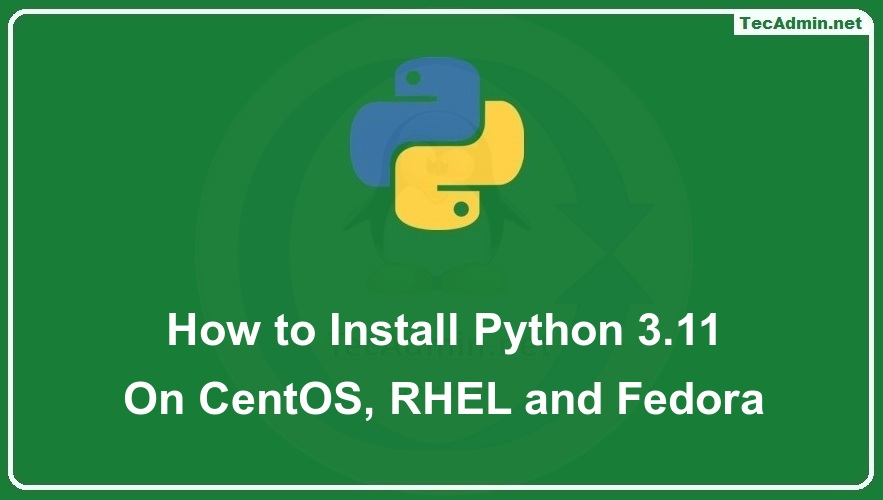Python 3.11 is recently launched with multiple improvements and security upgrades. This version provides developers to easily debug their code with fine-grained error locations in tracebacks. The new “Self” annotation provides a simple way to annotate methods that return an instance of their class. Mostly the latest operating systems come with the latest Python versions. But the OS versions released before the release of Python 3.11 may not have the latest version. This tutorial will help you to install Python 3.11 on your CentOS, Red Hat & Fedora operating systems by compiling it from source code. Requirements This Python installation…
Author: Rahul
The Linux Command Line Interface (CLI) is a text-based interface for interacting with the operating system. Users can enter commands, which the system then interprets and carries out to the kernel. It allows the user to navigate the file system, manage files, and perform various other tasks. The command line interface is a powerful tool for advanced users and is often used for tasks such as automation, scripting, and system administration. Most of the Linux servers provide CLI only for interacting with the system, which is also the preferred way for system administrators. Many desktop users also love to use…
Managing databases in MySQL often requires the use of a privileged user or a super admin user who has all the permissions to read, write, update, and manage the databases. In MySQL, this is typically the ‘root’ user, but it is advisable to create separate super admin users for better security management. This article will guide you on how to create a super admin user in MySQL. It will include an explanation of each step, followed by an example to ensure a thorough understanding. Prerequisites To create a super admin user in MySQL, you will need: Access to MySQL command-line…
In most cases, when you are working with a text file, it is likely to have some blank spaces. These blank spaces may range from a few characters to a number of lines that are empty or have no information. Keeping such files with unnecessary spaces can be time-consuming and inconvenient. There may be several reasons for keeping these files, but the best way of handling them is by deleting the lines that are empty. This article explores the Unix sed command and its usage in deleting empty lines in a file. What Is Sed? Sed stands for stream editor.…
The .NET Framework is an essential part of the .NET ecosystem. It’s a collection of APIs that can be used to write applications and services in almost any programming language (including Ruby, Java, Python, C#, JavaScript, and many more). For most developers using .NET to build software, the .NET Framework isn’t something they need to understand in detail. Instead, it’s something that needs to be kept up to date for all of their projects as new versions are released. But what does the .NET Framework actually do? In this article, you’ll learn 4 ways to find the installed .NET framework…
For many computer users, the most stressful part of working with a Linux system is having to back up their data. The good news is that there is a simple solution to this problem: set up an automatic rsync backup script that will automatically keep your data safe. In this article, we will go over the tools and steps that you need to take to set up an automated backup system on a Linux system with rsync. You will learn how to use rsync to automatically create backups of files, how to keep these backups up-to-date, and how to restore…
The `sort` command in Linux is part of the GNU Coreutils package. This command is used to sort lines of text in a specified file or from the standard input in an ascending/descending order. The sorted output can be written to a file or displayed on the standard output. The `sort` command is a simple and powerful tool that can be used in various scenarios, from sorting data in a file for further analysis to preparing data for a report. In this article, we will discuss the various options available with the `sort` command and provide some practical examples to…
MySQL is a widely-used open-source relational database management system (RDBMS) that allows for efficient data storage and retrieval. However, users may occasionally encounter errors, such as the “ERROR 1114 (HY000): The table ‘table_name’ is full” message. This error occurs when the maximum allowed size for a table’s storage engine or the partition in which the table resides has been reached. In this response, we will explore different solutions to resolve this error and ensure smooth database operation. Possible Issue and Solution The “ERROR 1114 (HY000): The table ‘table_name’ is full” occurs when you’ve reached the maximum allowed size for the…
Flask is a popular microweb framework written in Python. It is lightweight and easy to use, making it a good choice for developing small web applications. It is designed to enable developers to create and scale web apps quickly and easily. It has a small and easy-to-extend core, with sensible defaults to get started quickly. In this article, we will show you how to install and use Flask on a Fedora system. Prerequisites Before you start, make sure that you have the following installed on your system: Python 3: Flask is a Python web framework, so you will need to…
The `sed` command is an essential tool for manipulating text in Linux. It allows you to search for patterns in a text and perform various operations on the matching text, such as replacing it, deleting it, or printing it. This command takes input from a file or standard input. The default sed command doesn’t make changes to the original file until you used the -i command line parameter. The command alerts the text and sends the result to standard output. You can also redirect the text to the file as per the requirements. In this article, we’ll provide 15 practical…



